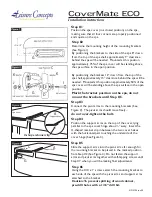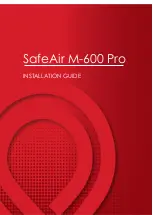
33
WARNING:
Never feed wood with your hands when making
any non-through cut such as rabbets or dadoes.
To avoid personal injury, always use push blocks,
push sticks, and featherboards.
When the cut is made, turn the saw off. Wait for the
blade to come to a complete stop before removing the
workpiece.
Unplug the saw.
Lower the blade and remove the screw holding the throat
plate in place. Remove the throat plate.
�
Raise the saw blade.
Unlock the bevel locking lever and move height/bevel
adjusting handwheel until bevel indicator shows a 30°
angle. Push the bevel locking lever toward the table to
relock it. Reinstall the blade guard assembly.
Check spreader alignment to the blade and adjust shims
if necessary.
Lift the bevel locking lever and move the blade back to
90°. Push the bevel locking lever toward the table to
relock it.
Lower the blade, insert the throat plate, then securely
tighten the throat plate screw.
NON-THROUGH CUT
BLADE
GUARD
REMOVED
PUSH STICK
Fig. 44
OPERATION
MAKING A NON-THROUGH CUT
See Figure 44.
Non-through cuts can be made with the grain (ripping) or
across the grain (cross cut). The use of a non-through cut is
essential to cutting grooves, rabbets, and dadoes.
NOTE:
This is the only type of cut that is made without the
blade guard assembly installed. Make sure the blade guard as-
sembly is reinstalled upon completion of this type of cut.
Read the appropriate section which describes the type of
cut in addition to this section on non-through or dado cuts.
For example, if your non-through cut is a straight cross
cut, read and understand the section on straight cross cuts
before proceeding.
Unplug the saw.
Lower the blade and remove the screw holding the throat
plate in place. Remove the throat plate.
Raise the saw blade.
Unlock the bevel locking lever and move height/bevel
adjusting handwheel until bevel indicator shows a 30°
angle. Push the bevel locking lever toward the table to
relock it.
Remove the blade guard assembly.
NOTE:
To remove and replace blade guard and spreader
for non-through cuts without disturbing the spreader
alignment, loosen the blade guard locking knob. Do not
loosen other screws.
Lower the blade and insert the throat plate, then securely
tighten the throat plate screw.
Bring the blade back to 90°.
Raise the blade to the correct height by turning the
height/bevel adjusting handwheel clockwise.
NOTE:
Carefully check all setups and rotate the blade
one full revolution to assure proper clearance before
connecting saw to power source.
Feed the workpiece into the blade.
Always use push blocks, push sticks, and featherboards
when making non-through cuts to avoid the risk of serious
injury.
WARNING:
When making a non-through cut, the cutter is
covered by the workpiece during most of the cut.
Be alert to the exposed cutter at the start and
finish of every cut to avoid the risk of personal
injury.
15
0
30
0
0
3
3
2
2
4
4
5
6
7
8
9
15
14
13
12
11
10
9
1
1
8
10
11
12
13
14
Содержание TS2400LS
Страница 44: ...44 NOTES ...














































